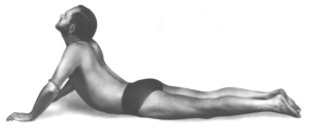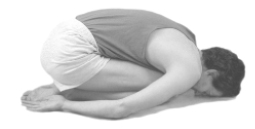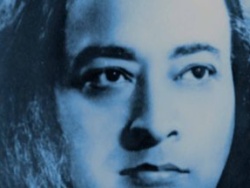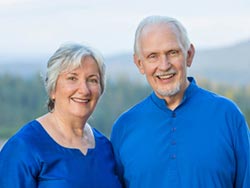It is very helpful for both meditation and overall health to increase flexibility in the spine. Here are two simple stretches to accomplish that goal. But first, a couple of cautions:
1) Never push past your comfort level when stretching. Always relax into a pose. Never force yourself.
2) Never hold a posture longer than is comfortable. A few seconds up to a minute is sufficient to start with.
Here are some very simple stretches to help you relax in preparation for meditation. They will stretch the spine, helping to relax and energize you for meditation. Those with more interest can learn Hatha Yoga postures in much greater depth. They are extremely beneficial for the body, but are much more than a series of stretches. They are part of a whole science of yoga and, when done with deep attention, can lead to a greatly expanded state of consciousness.
The Cobra Pose (Bhujangasana)—a Simple Backward Stretch
Lie face downward, with your palms on the floor next to your shoulders and your forehead resting on the floor. Keep the elbows close to the body. Now raise your head and feel the tension in the back of the neck. Continue to draw the head backward as far as you can, using the back and neck muscles alone. Now use your arms to push yourself upward, letting your spine stretch and bend backward. Feel the stretch, and the resulting release of energy, moving from the head downward to the base of the spine.
 Stretch backward as far as is comfortable, keeping your navel on the floor. Relax as completely as possible, breathing normally, holding this position for 10 to 30 seconds (or more if it is completely comfortable). Now slowly lower the forehead back to the floor, feeling a reverse flow of energy up the spine. If there is any strain, do a gentler variation by keeping the elbows on the floor as you stretch up and back.
Stretch backward as far as is comfortable, keeping your navel on the floor. Relax as completely as possible, breathing normally, holding this position for 10 to 30 seconds (or more if it is completely comfortable). Now slowly lower the forehead back to the floor, feeling a reverse flow of energy up the spine. If there is any strain, do a gentler variation by keeping the elbows on the floor as you stretch up and back.
Repeat this stretch two or three times.
There is an innate connection between body posture and mental attitude. When we feel good we naturally tend to stand up straight. And when we feel depressed, we slump. The yoga postures help create a positive flow of energy and consequently an uplifted mental state. But, we can increase this effect greatly if we also engage the mind. The way to do this is with affirmation. The position of the Cobra Pose helps us to feel life affirming and victorious. Increase this attitude by affirming, “I rise determinedly to meet all obstacles.” Repeat this mentally several times as you stretch upward.
The Child Pose (Balasana)
It is always good to balance a stretch of the spine in one direction with another stretch in the opposite direction. Here is a very gentle forward stretch (a variation of the Hare Pose.) 
Sit on your calves with your legs underneath you. Your right big toe should be over your left big toe. If you feel a strain on your legs you can use a small cushion on top of or under your ankles to relieve the pressure. Now bend forward, exhaling as you do so, until your head touches the floor a few inches in front of your knees. Let your arms rest beside your legs. Hold this position for a few seconds (up to a minute if it is completely comfortable), relaxing completely and breathing normally. Return slowly to an upright position and relax for a minute or so. While in the Child’s Pose you can affirm, “I am your child, Lord. I trust You in all things.”
The Corpse Pose (Savasana)
Begin, as you did for diaphragmatic breathing, lying on your back with your arms at your sides and your palms facing up. Practice diaphragmatic breathing for a few minutes, relaxing more and more deeply. Pay special attention to releasing all tension in your abdomen, feeling it rise and fall like the tide. Now relax individual areas of your body as deeply as possible, starting with your feet and working your way up slowly to your head. It helps to visualize the area you are relaxing becoming filled with space or full of light. Some people prefer to feel that their body is growing heavy rather than light—experiment to see what works best for you.
Start with your feet. Relax them, letting all tension go. Now, deeply relax your calves, and then gradually move up your legs. Pay particular attention to the back of your knees, a place where many people hold tension. Continue up your body, releasing tension in your thighs, hips, and buttocks. Relax each and every part as deeply as you possibly can. Now continue, letting go of all strain in your abdomen and then your chest and shoulders. People often hold tension in their stomach and shoulders, so relax these areas deeply. Continue on, relaxing your neck, jaw, chin, and tongue. Then relax your cheeks and finally your eyes and eyelids. Remain in this
deeply relaxed state for several minutes, occasionally checking your body to see if you can find any spots of tension. Now, sit up, but try to remain as relaxed as possible as you do so.








